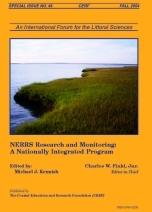The lagoons that border the east coast of the Florida peninsula provide an opportunity to study water chemistry and phytoplankton characteristics over a wide range of water residence and nutrient load conditions. This article includes the results of a 2-year study of eight study sites. The northern half of the sampling range included four sampling sites within the newly established Guana Tolomato Matanzas National Estuarine Research Reserve. The southern half of the sampling range consisted of four study sites distributed in ecologically distinct sub-basins of the Indian River Lagoon. The Guana Tolomato Matanzas National Estuarine Research Reserve and Indian River Lagoon include estuaries with water residence times ranging from days to months and watersheds with widely differing nutrient load characteristics. The results of this study revealed wide temporal and spatial variability of physical and chemical characteristics. Mean salinities for the study period ranged from 9.7 to 31.5‰ over the eight sites. Mean orthophosphate and total phosphorus concentrations ranged from 0.26 to 1.55 μM and 1.45 to 3.00 μM, respectively. Mean dissolved inorganic nitrogen and total nitrogen concentrations ranged from 3.14 to 9.77 μM and 26.43 to 71.14 μM, respectively. Individual phytoplankton standing crops, in terms of chlorophyll a concentrations, ranged from less than 1 μg L−1 to more than 60 μg L−1. Comparisons of the relationships between nutrient and phytoplankton standing crops at the eight study sites indicated that water residence times and nutrient loads provided important insights into the basis for observed temporal and spatial patterns of variability. Indices for water residence time and nutrient load were determined for each site. A combination of the character of watershed inputs and residence time was most useful in interpreting patterns of nutrient concentrations, whereas water residence time appeared to be the pre-eminent factor dictating phytoplankton standing crop potential among the eight study sites.
How to translate text using browser tools
1 November 2004
A Comparison of Water Quality and Hydrodynamic Characteristics of the Guana Tolomato Matanzas National Estuarine Research Reserve and the Indian River Lagoon of Florida
Edward J. Phlips,
Natalie Love,
Susan Badylak,
Phyllis Hansen,
Jean Lockwood,
Chandy V. John,
Richard Gleeson
ACCESS THE FULL ARTICLE

Journal of Coastal Research
Vol. 2009 • No. 10045
Fall 2004
Vol. 2009 • No. 10045
Fall 2004
chlorophyll a
Guana River
Matanzas River
nitrogen
nutrient load
phosphorus
phytoplankton




